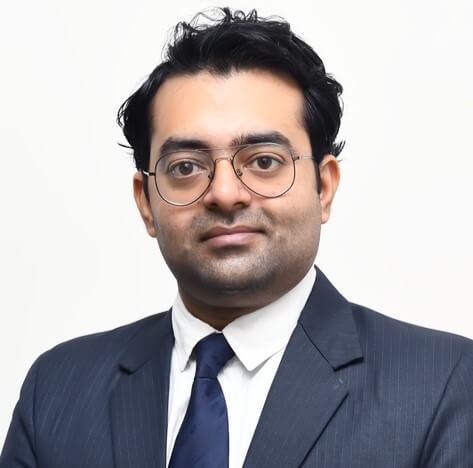Faculty

Dr. Kul Vaibhav Sharma
Assistant Professor
Bio
Dr. Kul Vaibhav Sharma is a distinguished Assistant Professor and Internship Coordinator in the Department of Civil Engineering at Dr.Vishwanath Karad MIT World Peace University, Pune, India. With extensive expertise in civil engineering and geospatial technologies, he excels in teaching, research, and fostering industry-academia collaborations to enhance student employability. He holds a Ph.D. in Remote Sensing & GIS (2021) and an M.Tech. in Urban Planning (2015) from Malaviya National Institute of Technology (MNIT), Jaipur, as well as a B.Tech. in Civil Engineering from Rajasthan Technical University, Kota (2012), establishing a strong academic foundation.With over 5 years of teaching, 2.5 years of industry, and 5 years of research experience, Dr. Sharma brings a wealth of expertise to his academic and professional endeavors.
Dr. Sharma serves as a reviewer for prestigious journals, including ASCE Journal of Environmental Engineering, Journal of Water and Climate Change (IWA), Water Resources Management (Springer), and Pattern Analysis and Applications (Springer), contributing significantly to the advancement of civil engineering and geospatial research. His research portfolio includes 44 Scopus-indexed and 36 SCI/SCIE journal articles (H-index: 12), 11 international conference publications with Best Paper Awards, a book titled Waterpower Engineering (2022, ISBN:9789395951630), and 4 book chapters in Springer Lecture Notes and other series. Notable publications include works on warm mix asphalt,landslide forecasting with deep learning, and flood forecasting using machine learning.
Dr. Sharma delivers innovative courses in Data Science for Civil Engineering, AI & Machine Learning for Infrastructure Engineering, Internet of Things (IoT), Remote Sensing & GIS, Surveying, and Environmental Engineering, inspiring the next generation of engineers. Dr. Sharma holds three design patents granted by The Patent Office, Government of India: Traffic Control Hologram Projector (Patent No. 397638-001, 2024), Concrete Bridge Health Analysis Device (Patent No. 409038-001, 2024), and Construction Material Quality Checker (Patent No. 412335-001, 2024). As an organizer of academic events, he has led initiatives such as the Faculty Development Program on Innovations in Civil Engineering and Construction Practices (2024), the International Conference on Sustainable Energy, Environment, and Green Technologies, and workshops on ICT-based teaching methodologies with IIT Bombay. Dr. Sharma’s technical proficiency spans civil engineering software (AutoCAD, MX Road, STAAD Pro, ETabs, Civil 3D), programming languages (Python, MATLAB), and statistical tools (Minitab, SPSS, Primavera, MS Project). He excels in passive remote sensing with ArcGIS, ERDAS Imagine, ENVI, and Google Earth Engine, active remote sensing with Drone-UAV Aviation and ESA SNAP, raster image processing with Adobe Photoshop, and 3D modelling with Google SketchUp, enabling innovative solutions in civil engineering and geospatial applications.
Research Papers
1. Kul Vaibhav Sharma, Vijendra Kumar, Karan Singh, Darshan J. Mehta. “LANDSAT 8 LST Pan sharpening using novel principal component based downscaling model” Published in Remote Sensing Applications: Society and Environment, Volume 30, April 2023, 100963. DOI: https://doi.org/10.1016/j.rsase.2023.100963 (Impact Factor: 4.7) Q1
2. Pawar, N.S., Sharma, K.V., “Comprehensive review of remote sensing integration with deep learning in landslide forecasting and future directions” Published in Natural Hazards, 2025, DOI: https://doi.org/10.1007/s11069-025-07171-w (Impact Factor: 3.3) Q1
3. Kul Vaibhav Sharma, Viral Parmar, Lilesh Gautam, Sumit Choudhary, Jigar Gohil. “Mod-elling efficiency of fluid viscous dampers positioning for increasing tall buildings' Resili-ence to earthquakes induced structural vibrations” Published in Soil Dynamics and Earth-quake Engineering, Volume 173, October 2023, 108108. DOI: https://doi.org/10.1016/j.soildyn.2023.108108 (Impact Factor: 4) Q1
Patents
Indian Patent Granted ""GPS Tracking Device with Dual Charging and Multi-Point Mounting Application Number: 449862-001, CBR Number: 204331 "
Research Area
Remote Sensing and GIS, Downscaling, Land Surface Temperature, Geo-Informatics, Agricultural Planning, Disaster Management by GIS
Publication
1. Kul Vaibhav Sharma, Vijendra Kumar, Karan Singh, Darshan J. Mehta. “LANDSAT 8 LST Pan sharpening using novel principal component based downscaling model” Published in Remote Sensing Applications: Society and Environment. Volume 30, April 2023, 100963. DOI:https://doi.org/10.1016/j.rsase.2023.100963 (Impact Factor: 4.93)
2. Karan Singh, Parveen Sihag,Vijendra Kumar & Kul Vaibhav Sharma. “Development and application of modeling techniques to estimate the unsaturated hydraulic conductivity” Published in Modeling Earth Systems and Environment. DOI: https://doi.org/10.1007/s40808-023-01744-z (Impact Factor: 3.9)
3. Kul Vaibhav Sharma, Sumit Khandelwal, Nivedita Kaul. “Comparative assessment of Vegetation Indices in Downscaling of MODIS Satellite Land Surface Temperature (LST)”. Published in Springer Journal: Remote sensing in Earth system science. DOI: 10.1007/s41976-020-00040-z (Impact Factor: 3.1)
4. Kul Vaibhav Sharma, Sumit Khandelwal, Nivedita Kaul. “Principal Component-based Fusion of Land surface temperature (LST) and Panchromatic (PAN) images” Published in Springer Journal: Spatial Information Research. DOI: 10.1007/s41324-020-00333-x (Impact Factor: 2.16)
5.Kul Vaibhav Sharma, Sumit Khandelwal, Nivedita Kaul. “Downscaling of Coarse Resolution Land Surface Temperature through Vegetation Indices Based Regression Models” Published in Springer book: Application of Geometrics in civil Engineering. © Springer Nature Singapore, ISBN978-981-13-7067-0, pp. 625-636, DOI: 10.1007/978-981-13-7067-0_51 (Impact Factor: 0.46)
6. Kul Vaibhav Sharma, Sumit Khandelwal, Nivedita Kaul. “Intensity Transformation Fusion of Landsat 8 Thermal Infrared (TIR) Imagery”, Advances in Intelligent Systems and Computing book series, © Springer Nature Switzerland, (AISC, volume 1122), ISBN: 978-3-030-39874-3, pp. 214-220, DOI: https://doi.org/10.1007/978-3-030-39875-0_23 (Impact Factor: 0.61)
Google Scholar Link https://scholar.google.com/citations?user=FdRXqdMAAAAJ&hl=en&authuser=2
Scopus Link
https://www.scopus.com/authid/detail.uri?authorId=57209419940
Orcid Linkhttps://orcid.org/0000-0002-8559-3647





 admissions@mitwpu.edu.in
admissions@mitwpu.edu.in
